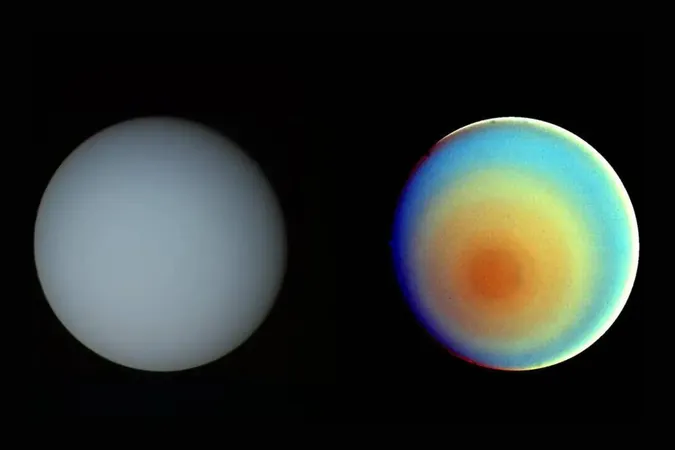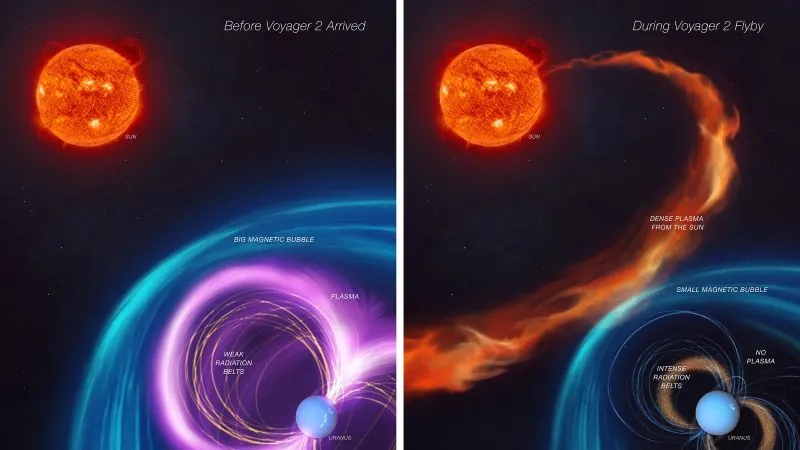
Shocking Revelations from Voyager 2's 1986 Encounter with Uranus!
2024-11-11
Author: Yan
Groundbreaking Analysis Unveils Unexpected Findings
A groundbreaking analysis of Voyager 2’s historic flyby of Uranus has unveiled unexpected findings, suggesting that the spacecraft witnessed the planet in a rare and significant moment back in 1986. Published in Nature Astronomy, researchers have determined that Uranus’s magnetosphere was significantly disturbed due to an intense solar wind event, leading to an altered understanding of this enigmatic planet's magnetic environment.
Unusual Magnetosphere Observations
Initially, Voyager 2's data indicated that the Uranian magnetosphere was sparsely populated with plasma—a common feature in other planetary magnets. However, as scientists delved deeper into the age-old data, they discovered that this particular flyby occurred during a time when Uranus’s magnetosphere was not only bizarrely structured but also contained powerful belts of energetic electrons, making it distinctly different from its planetary peers.
Significance of Timing
Lead author Jamie Jasinski, a planetary scientist at NASA’s Jet Propulsion Laboratory, emphasized the implications of this phenomenon. He explained that if Voyager 2 had approached Uranus just a week earlier, the measurements and subsequent discoveries would have been dramatically different. This rare moment and high solar activity altered the scope of scientific inquiry regarding Uranus, which now appears to be a dynamic and peculiar world.
Rare Compression and Magnetic Conditions
According to estimates, the unusual compression of Uranus's magnetosphere happens only 4% of the time, lending weight to the importance of the timing of Voyager 2's observations. Significant variations in solar wind activity, particularly during solar minimums—a low point in the Sun’s 11-year cycle—suggest that Uranus experiences fluctuating magnetic conditions. The extreme tilt of Uranus relative to the solar system's orbital plane is also likely a contributing factor to its unique magnetospheric behavior.
The Voyager Mission's Contributions
The Voyager mission delivered unprecedented insights into Uranus, revealing 16 moons and six planetary rings during its journey. Now, after nearly 47 years in space, Voyager 2 travels through the interstellar void at a staggering speed of 34,391 miles per hour (55,347 kilometers per hour), positioned almost 13 billion miles (20.9 billion kilometers) from Earth. Light from the spacecraft now takes over 19 hours to reach us!
Focus on Uranus’s Moons
Scientists are particularly eager to enhance our understanding of Uranus’s moons, Titania and Oberon, which might be harboring subsurface oceans. This could open new avenues in astrobiology and planetary research. Jasinski highlighted the significance of these two particular moons; being slightly larger than others, they have a better potential to retain heat, decreasing the likelihood of being completely frozen and enhancing the possibility of containing liquid water beneath their icy crusts.
Call for Deeper Exploration
An overarching call for deeper exploration of Uranus has gained momentum, particularly following a 2022 report urging for a dedicated Uranus orbiter. Such a mission could perform crucial mapping of the planet’s gravitational and magnetic fields and deploy atmospheric probes to deepen our understanding of this distant giant.
Looking Ahead
As we remain in the long shadow of Voyager 2's discovery, excitement simmers for potential future missions to unlock the secrets of Uranus, but for now, scientists are working diligently, piecing together new insights from the treasure trove of data handed to us almost forty years ago. The quest to understand Uranus is far from over—will we finally venture back to uncover its mysteries? Only time will tell!


 Brasil (PT)
Brasil (PT)
 Canada (EN)
Canada (EN)
 Chile (ES)
Chile (ES)
 España (ES)
España (ES)
 France (FR)
France (FR)
 Hong Kong (EN)
Hong Kong (EN)
 Italia (IT)
Italia (IT)
 日本 (JA)
日本 (JA)
 Magyarország (HU)
Magyarország (HU)
 Norge (NO)
Norge (NO)
 Polska (PL)
Polska (PL)
 Schweiz (DE)
Schweiz (DE)
 Singapore (EN)
Singapore (EN)
 Sverige (SV)
Sverige (SV)
 Suomi (FI)
Suomi (FI)
 Türkiye (TR)
Türkiye (TR)